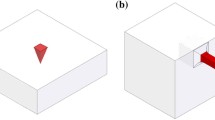Abstract
Plastic zones generated in double-cantilever-beam specimens of an Fe-3Si steel are revealed by etching. Zones corresponding to relative stress intensity levels in the range 0.4 √(in.)<K/σY< 0.8√(in.), beam height to length ratios H/W = 0.125 and 0.35, and conditions approaching plane strain are examined. The fürthest extent of the zones, p ≈ 0.13 (K/σY)2, is about half that previously observed in plates loaded in tension to comparable K-levels. The results are consistent with previous, measurements by Clark and lend support to Wilson's calculations. At high stress levels, when the zone size to beam height ratio ϱ/H≳ 0.09, the zone begins to tilt backwards and undergoes a transition from a crack- to a beam-zone. Implications of this transition with respect to the minimum beam height requirement are examined.
Résumé
Les zones de déformation plastique qui se développent dans des éprouvettes en forme de double poutre cantilever d'acier Fe-3Si ont été mises en évidence par attaque chimique. On envisage les zones correspondant aux conditions suivantes: niveaux relatifs de l'intensité de contraintes compris dans la fourchette: 0,4√(in)<K/σy<0,8√(in) et rapports hauteur/longueur de poutre H/W = 0,125 et 0,350. On examine les conditions voisines de l'état plan de déformation. L'épanouissement le plus large des zones, exprimé par ϱ ≈ 0,13 (K/σY)2, est la moitié de celui que l'on a observé précédemment dans le cas de tôles sollicitées en traction à des niveaux K comparables.
Ces résultats sont compatibles avec les mesures qu'a obtenues Clark, et confirment les calculs de Wilson. Sous contraintes élevées, lorsque le rapport de la dimension de la zone plastifiée à la hauteur de la poutre ϱ/H ≳ 0,09, cette zone commence à se cambrer vers l'arrière et passe de la fissure au corps même de la poutre.
On examine les implications que comporte cette transition sur les hauteurs minimum de poutres à observer.
Zusammenfassung
In Doppelkamileverproben aus Fe-3 Si-Stahl gebildete plastische Zonen werden durch Ätzen sichtbar gemacht. Zonen welche einem relativen Spannungsintensitätsniveau im Bereich von 0,4,√(in.)<K/σY< 0,8,√(in.) entsprechen, Höhen zu Längen-Verhältnisse H/W = 0,125 und 0,35 sowie Bedingungen, welche sich der planen Verformung annähern, werden untersucht.
Die größte Ausbreitung dieser Zonen, ϱ ≈ 0,13 (K/σY)2 erreicht nur die Hälfte derer die früher in Blechen beobachtet worden waren, welche bei gleichen K-Werten Zugspannungen ausgesetzt wurden. Diese Ergebnisse sind in guter Übereinstimmung mit den schon von Clark durchgeführten Messungen und bekräftigen die Berechnungen von Wilson.
Bei hohem Spannungsniveau, wo das Verhältnis ϱ/H ≳ 0,09 ist, beginnt die Zone sich nach rückwärts zu beugen und sich vom Rissbereich ins Innere des Trägers zu verschieben. Die sich hieraus ergebende Folgerung für die erforderliche minimale Trägerhöhe wird untersucht.
Similar content being viewed by others
References
R. G. Hoagland, On the Use of the Double-Cantilever-Beam Specimen for Determining the Plane Strain Fracture Toughness of Metals, Trans. ASME, 89 (1967) 525.
E. T. Wessel, State of the Art of the WOL Specimen for KIC Fracture Toughness Testing, Eng. Fracture Mech., 1 (1968) 77.
W. G. Clark, Jr., Visual Observation of the Crack Tip Plastic Zone Developed in a 3 Per Cent Si-Fe Alloys, Westinghouse Scientific Paper, 66-1D6-BTLFR-P1, September 27, 1966.
G. T. Hahn and A. R. Rosenfield, Plastic Flow in the Locale on Notches and Cracks in Fe-3Si Steel Under Conditions Approaching Plane Strain, Ship Structure Committee Report-191, November 1968.
W. K. Wilson, Geometry and Loading Effects on Elastic Stresses at Crack Tips, Westinghouse Research Report 67-1D7-BTLPV-RI Properietary Class 3, July 3, 1967.
M. L. Willismas, On the Stress Distribution at the Base of a Stationary Crack, Trans ASME, 79 (1957) 109.
G. T. Hahn, A. R. Rosenfield and M. Sarrate, Observations of Yielding Accompanying Crack Growth, Inelastic Behavior of Solids, McGraw-Hill, New York (1970) 673.
G. T. Hahn, M. Sarrate and A. R. Rosenfield, Experiments on the Nature of the Fatigue Crack Plastic Zone, Proc. A.F. Conf. Fatigue and Fracture, Miami, December, 1969; also AFML TR-67-143 Part III, January, 1970.
G. T. Hahn, P. N. Mincer and A. R. Rosenfield, The Fe-3Si Steel Etching Technique for Local Strain Measurement (submitted to Experimental Mechanics).
M. F. Kanninen, An Augmented Double Cantilever Beam Model for Investigating Unstable Crack Propaagion and Arrest (to be published).
Author information
Authors and Affiliations
Rights and permissions
About this article
Cite this article
Hahn, G.T., Sarrate, M. & Rosenfield, A.R. Plastic zones in Fe-3Si steel double-cantilever-beam specimens. Int J Fract 7, 435–446 (1971). https://doi.org/10.1007/BF00189113
Received:
Revised:
Issue Date:
DOI: https://doi.org/10.1007/BF00189113




